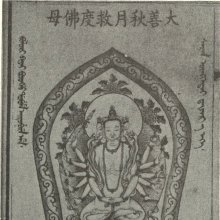Candrakantitara, Candrakāntitārā, Candrakanti-tara: 1 definition
Introduction:
Candrakantitara means something in Buddhism, Pali. If you want to know the exact meaning, history, etymology or English translation of this term then check out the descriptions on this page. Add your comment or reference to a book if you want to contribute to this summary article.
Alternative spellings of this word include Chandrakantitara.
Images (photo gallery)
In Buddhism
Tibetan Buddhism (Vajrayana or tantric Buddhism)
Source: Rangjung Yeshe Wiki: Dharma DictionaryCandrakāntitārā (चन्द्रकान्तितारा) (in Tibetan: དཀར་མོ་ཟླ་མདངས་ཀྱི་སྒྲོལ་མ) refers to the “Tārā who is as white as autumn moon” and represents one of the twenty-one emanations of Tārā according to the Kashmiri Mahasiddha Suryagupta Tradition.—Suryagupta or Ravigupta (Tibetan: nyi ma be pa) was a layperson from Kashmir that was cured of leprosy by a miraculous statue of the goddess Tara. Suryagupta is famous for having many visions of Tara and originating many lineages of her practice such as the Twenty-one forms of Tara [e.g., Candrakāntitārā]. There exists inscriptions and paintings (from the 14th century) of these Twenty-one Taras and they are also described in ritual and meditation texts in both Sanskrit and Tibetan language.

Tibetan Buddhism includes schools such as Nyingma, Kadampa, Kagyu and Gelug. Their primary canon of literature is divided in two broad categories: The Kangyur, which consists of Buddha’s words, and the Tengyur, which includes commentaries from various sources. Esotericism and tantra techniques (vajrayāna) are collected indepently.
See also (Relevant definitions)
Partial matches: Candrakanti, Candrakanta, Tara.
Full-text: Candrakanti.
Relevant text
No search results for Candrakantitara, Candrakāntitārā, Candrakānti-tārā, Candrakanti-tara; (plurals include: Candrakantitaras, Candrakāntitārās, tārās, taras) in any book or story.
Related products
